Sustainable Event Development: Pollution and Climate Change in Cities
VerifiedAdded on 2020/04/21
|12
|3273
|86
Case Study
AI Summary
This case study report investigates the critical issue of pollution and its impact on climate change in major cities of developing countries, specifically focusing on Cape Town, South Africa, and Lagos, Nigeria. The study examines the effects of rapid population growth, inadequate waste management, and industrial activities on water, air, and land quality. It highlights the various types of pollution, including water contamination from industrial waste, air pollution from toxic gas emissions and burning of non-biodegradable materials, land degradation from mining and industrial residues, and deforestation due to urban expansion. The report analyzes the consequences of these pollutions, such as reduced water supply, health risks, and climate change impacts. The study aims to formulate strategies for sustainable event development, offering recommendations to mitigate pollution and climate risks, ultimately contributing to long-term goals and global environmental sustainability. The case study also draws from previous research, identifying gaps and proposing mitigation strategies to address these challenges, making it a valuable resource for residents, governments, international organizations, and future research efforts.
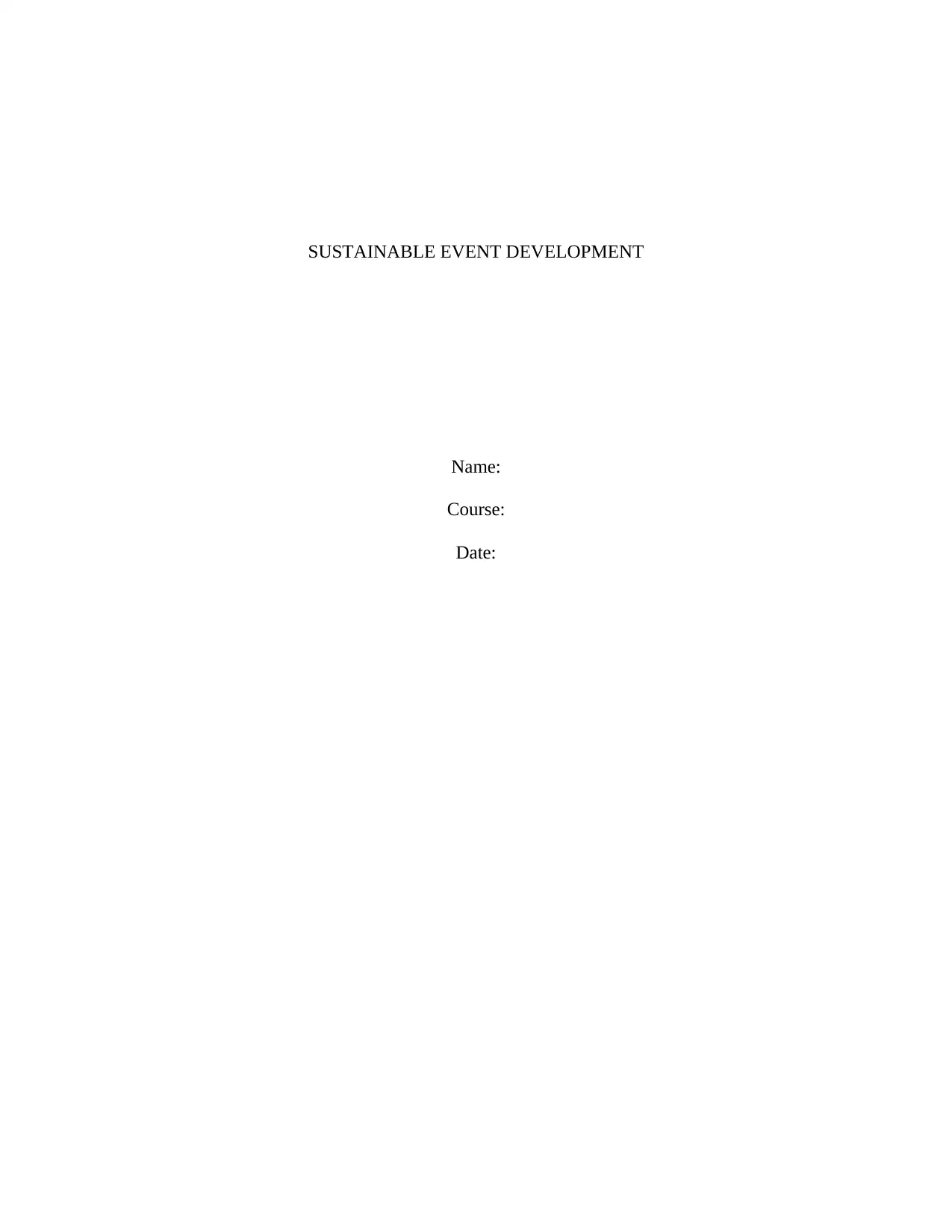
SUSTAINABLE EVENT DEVELOPMENT
Name:
Course:
Date:
Name:
Course:
Date:
Paraphrase This Document
Need a fresh take? Get an instant paraphrase of this document with our AI Paraphraser
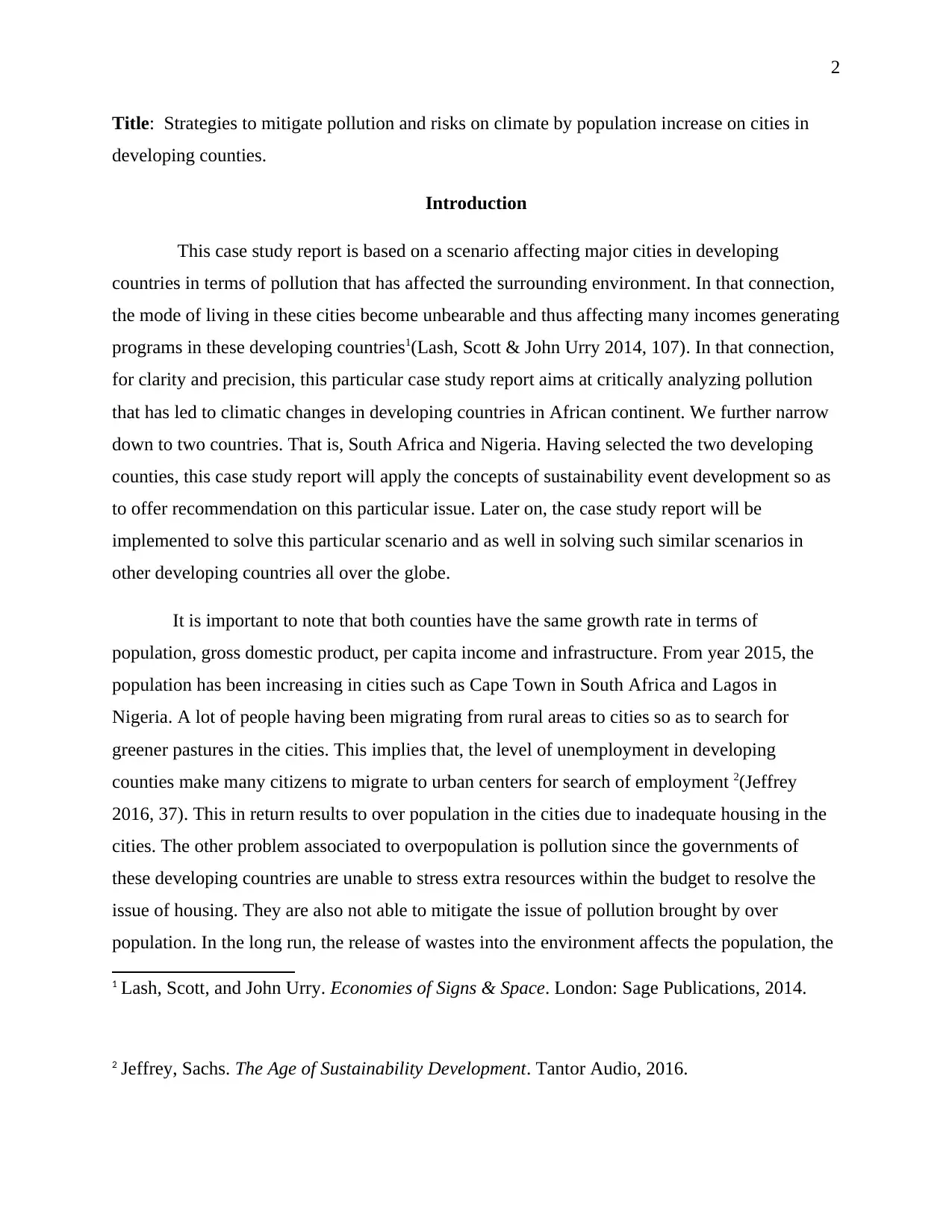
2
Title: Strategies to mitigate pollution and risks on climate by population increase on cities in
developing counties.
Introduction
This case study report is based on a scenario affecting major cities in developing
countries in terms of pollution that has affected the surrounding environment. In that connection,
the mode of living in these cities become unbearable and thus affecting many incomes generating
programs in these developing countries1(Lash, Scott & John Urry 2014, 107). In that connection,
for clarity and precision, this particular case study report aims at critically analyzing pollution
that has led to climatic changes in developing countries in African continent. We further narrow
down to two countries. That is, South Africa and Nigeria. Having selected the two developing
counties, this case study report will apply the concepts of sustainability event development so as
to offer recommendation on this particular issue. Later on, the case study report will be
implemented to solve this particular scenario and as well in solving such similar scenarios in
other developing countries all over the globe.
It is important to note that both counties have the same growth rate in terms of
population, gross domestic product, per capita income and infrastructure. From year 2015, the
population has been increasing in cities such as Cape Town in South Africa and Lagos in
Nigeria. A lot of people having been migrating from rural areas to cities so as to search for
greener pastures in the cities. This implies that, the level of unemployment in developing
counties make many citizens to migrate to urban centers for search of employment 2(Jeffrey
2016, 37). This in return results to over population in the cities due to inadequate housing in the
cities. The other problem associated to overpopulation is pollution since the governments of
these developing countries are unable to stress extra resources within the budget to resolve the
issue of housing. They are also not able to mitigate the issue of pollution brought by over
population. In the long run, the release of wastes into the environment affects the population, the
1 Lash, Scott, and John Urry. Economies of Signs & Space. London: Sage Publications, 2014.
2 Jeffrey, Sachs. The Age of Sustainability Development. Tantor Audio, 2016.
Title: Strategies to mitigate pollution and risks on climate by population increase on cities in
developing counties.
Introduction
This case study report is based on a scenario affecting major cities in developing
countries in terms of pollution that has affected the surrounding environment. In that connection,
the mode of living in these cities become unbearable and thus affecting many incomes generating
programs in these developing countries1(Lash, Scott & John Urry 2014, 107). In that connection,
for clarity and precision, this particular case study report aims at critically analyzing pollution
that has led to climatic changes in developing countries in African continent. We further narrow
down to two countries. That is, South Africa and Nigeria. Having selected the two developing
counties, this case study report will apply the concepts of sustainability event development so as
to offer recommendation on this particular issue. Later on, the case study report will be
implemented to solve this particular scenario and as well in solving such similar scenarios in
other developing countries all over the globe.
It is important to note that both counties have the same growth rate in terms of
population, gross domestic product, per capita income and infrastructure. From year 2015, the
population has been increasing in cities such as Cape Town in South Africa and Lagos in
Nigeria. A lot of people having been migrating from rural areas to cities so as to search for
greener pastures in the cities. This implies that, the level of unemployment in developing
counties make many citizens to migrate to urban centers for search of employment 2(Jeffrey
2016, 37). This in return results to over population in the cities due to inadequate housing in the
cities. The other problem associated to overpopulation is pollution since the governments of
these developing countries are unable to stress extra resources within the budget to resolve the
issue of housing. They are also not able to mitigate the issue of pollution brought by over
population. In the long run, the release of wastes into the environment affects the population, the
1 Lash, Scott, and John Urry. Economies of Signs & Space. London: Sage Publications, 2014.
2 Jeffrey, Sachs. The Age of Sustainability Development. Tantor Audio, 2016.
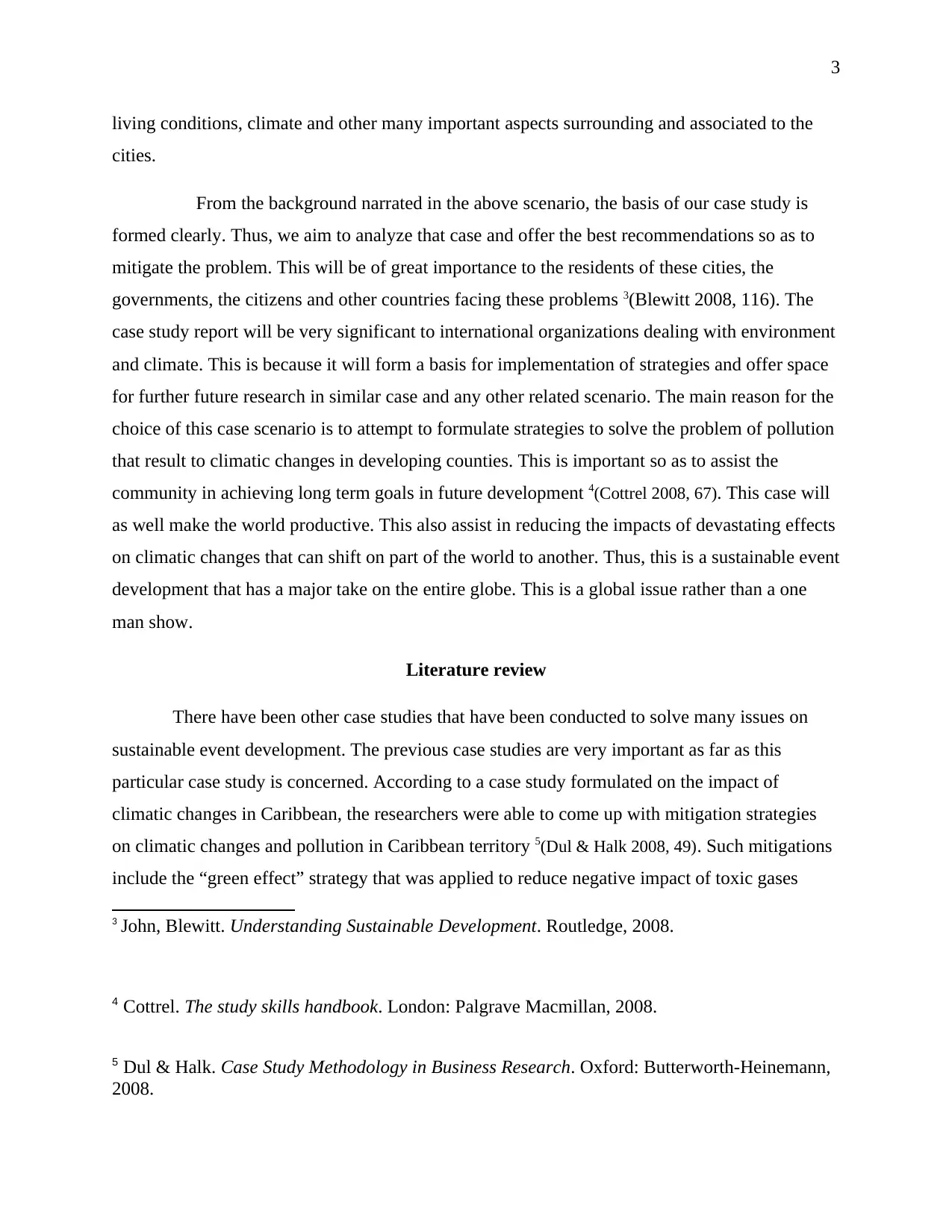
3
living conditions, climate and other many important aspects surrounding and associated to the
cities.
From the background narrated in the above scenario, the basis of our case study is
formed clearly. Thus, we aim to analyze that case and offer the best recommendations so as to
mitigate the problem. This will be of great importance to the residents of these cities, the
governments, the citizens and other countries facing these problems 3(Blewitt 2008, 116). The
case study report will be very significant to international organizations dealing with environment
and climate. This is because it will form a basis for implementation of strategies and offer space
for further future research in similar case and any other related scenario. The main reason for the
choice of this case scenario is to attempt to formulate strategies to solve the problem of pollution
that result to climatic changes in developing counties. This is important so as to assist the
community in achieving long term goals in future development 4(Cottrel 2008, 67). This case will
as well make the world productive. This also assist in reducing the impacts of devastating effects
on climatic changes that can shift on part of the world to another. Thus, this is a sustainable event
development that has a major take on the entire globe. This is a global issue rather than a one
man show.
Literature review
There have been other case studies that have been conducted to solve many issues on
sustainable event development. The previous case studies are very important as far as this
particular case study is concerned. According to a case study formulated on the impact of
climatic changes in Caribbean, the researchers were able to come up with mitigation strategies
on climatic changes and pollution in Caribbean territory 5(Dul & Halk 2008, 49). Such mitigations
include the “green effect” strategy that was applied to reduce negative impact of toxic gases
3 John, Blewitt. Understanding Sustainable Development. Routledge, 2008.
4 Cottrel. The study skills handbook. London: Palgrave Macmillan, 2008.
5 Dul & Halk. Case Study Methodology in Business Research. Oxford: Butterworth-Heinemann,
2008.
living conditions, climate and other many important aspects surrounding and associated to the
cities.
From the background narrated in the above scenario, the basis of our case study is
formed clearly. Thus, we aim to analyze that case and offer the best recommendations so as to
mitigate the problem. This will be of great importance to the residents of these cities, the
governments, the citizens and other countries facing these problems 3(Blewitt 2008, 116). The
case study report will be very significant to international organizations dealing with environment
and climate. This is because it will form a basis for implementation of strategies and offer space
for further future research in similar case and any other related scenario. The main reason for the
choice of this case scenario is to attempt to formulate strategies to solve the problem of pollution
that result to climatic changes in developing counties. This is important so as to assist the
community in achieving long term goals in future development 4(Cottrel 2008, 67). This case will
as well make the world productive. This also assist in reducing the impacts of devastating effects
on climatic changes that can shift on part of the world to another. Thus, this is a sustainable event
development that has a major take on the entire globe. This is a global issue rather than a one
man show.
Literature review
There have been other case studies that have been conducted to solve many issues on
sustainable event development. The previous case studies are very important as far as this
particular case study is concerned. According to a case study formulated on the impact of
climatic changes in Caribbean, the researchers were able to come up with mitigation strategies
on climatic changes and pollution in Caribbean territory 5(Dul & Halk 2008, 49). Such mitigations
include the “green effect” strategy that was applied to reduce negative impact of toxic gases
3 John, Blewitt. Understanding Sustainable Development. Routledge, 2008.
4 Cottrel. The study skills handbook. London: Palgrave Macmillan, 2008.
5 Dul & Halk. Case Study Methodology in Business Research. Oxford: Butterworth-Heinemann,
2008.
⊘ This is a preview!⊘
Do you want full access?
Subscribe today to unlock all pages.

Trusted by 1+ million students worldwide
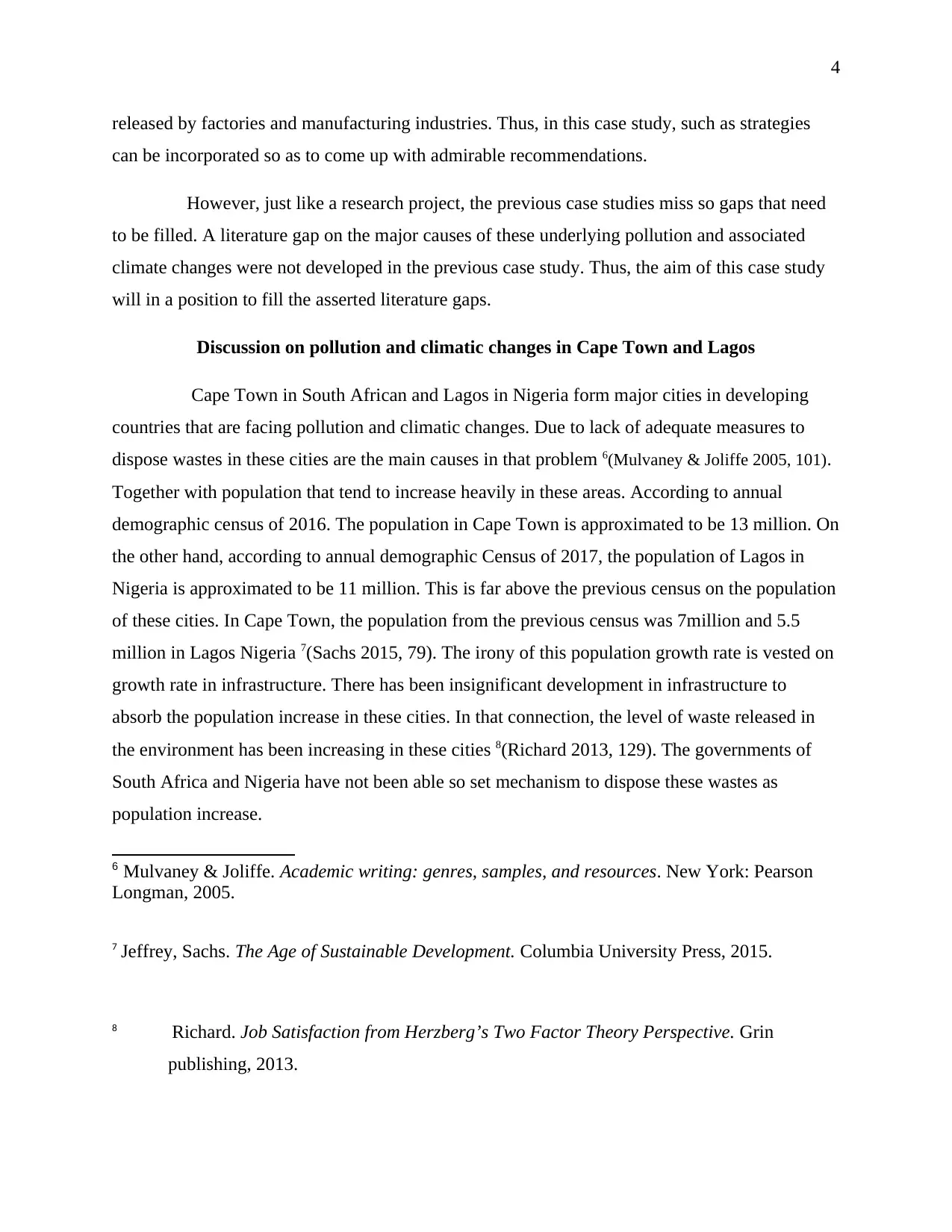
4
released by factories and manufacturing industries. Thus, in this case study, such as strategies
can be incorporated so as to come up with admirable recommendations.
However, just like a research project, the previous case studies miss so gaps that need
to be filled. A literature gap on the major causes of these underlying pollution and associated
climate changes were not developed in the previous case study. Thus, the aim of this case study
will in a position to fill the asserted literature gaps.
Discussion on pollution and climatic changes in Cape Town and Lagos
Cape Town in South African and Lagos in Nigeria form major cities in developing
countries that are facing pollution and climatic changes. Due to lack of adequate measures to
dispose wastes in these cities are the main causes in that problem 6(Mulvaney & Joliffe 2005, 101).
Together with population that tend to increase heavily in these areas. According to annual
demographic census of 2016. The population in Cape Town is approximated to be 13 million. On
the other hand, according to annual demographic Census of 2017, the population of Lagos in
Nigeria is approximated to be 11 million. This is far above the previous census on the population
of these cities. In Cape Town, the population from the previous census was 7million and 5.5
million in Lagos Nigeria 7(Sachs 2015, 79). The irony of this population growth rate is vested on
growth rate in infrastructure. There has been insignificant development in infrastructure to
absorb the population increase in these cities. In that connection, the level of waste released in
the environment has been increasing in these cities 8(Richard 2013, 129). The governments of
South Africa and Nigeria have not been able so set mechanism to dispose these wastes as
population increase.
6 Mulvaney & Joliffe. Academic writing: genres, samples, and resources. New York: Pearson
Longman, 2005.
7 Jeffrey, Sachs. The Age of Sustainable Development. Columbia University Press, 2015.
8 Richard. Job Satisfaction from Herzberg’s Two Factor Theory Perspective. Grin
publishing, 2013.
released by factories and manufacturing industries. Thus, in this case study, such as strategies
can be incorporated so as to come up with admirable recommendations.
However, just like a research project, the previous case studies miss so gaps that need
to be filled. A literature gap on the major causes of these underlying pollution and associated
climate changes were not developed in the previous case study. Thus, the aim of this case study
will in a position to fill the asserted literature gaps.
Discussion on pollution and climatic changes in Cape Town and Lagos
Cape Town in South African and Lagos in Nigeria form major cities in developing
countries that are facing pollution and climatic changes. Due to lack of adequate measures to
dispose wastes in these cities are the main causes in that problem 6(Mulvaney & Joliffe 2005, 101).
Together with population that tend to increase heavily in these areas. According to annual
demographic census of 2016. The population in Cape Town is approximated to be 13 million. On
the other hand, according to annual demographic Census of 2017, the population of Lagos in
Nigeria is approximated to be 11 million. This is far above the previous census on the population
of these cities. In Cape Town, the population from the previous census was 7million and 5.5
million in Lagos Nigeria 7(Sachs 2015, 79). The irony of this population growth rate is vested on
growth rate in infrastructure. There has been insignificant development in infrastructure to
absorb the population increase in these cities. In that connection, the level of waste released in
the environment has been increasing in these cities 8(Richard 2013, 129). The governments of
South Africa and Nigeria have not been able so set mechanism to dispose these wastes as
population increase.
6 Mulvaney & Joliffe. Academic writing: genres, samples, and resources. New York: Pearson
Longman, 2005.
7 Jeffrey, Sachs. The Age of Sustainable Development. Columbia University Press, 2015.
8 Richard. Job Satisfaction from Herzberg’s Two Factor Theory Perspective. Grin
publishing, 2013.
Paraphrase This Document
Need a fresh take? Get an instant paraphrase of this document with our AI Paraphraser
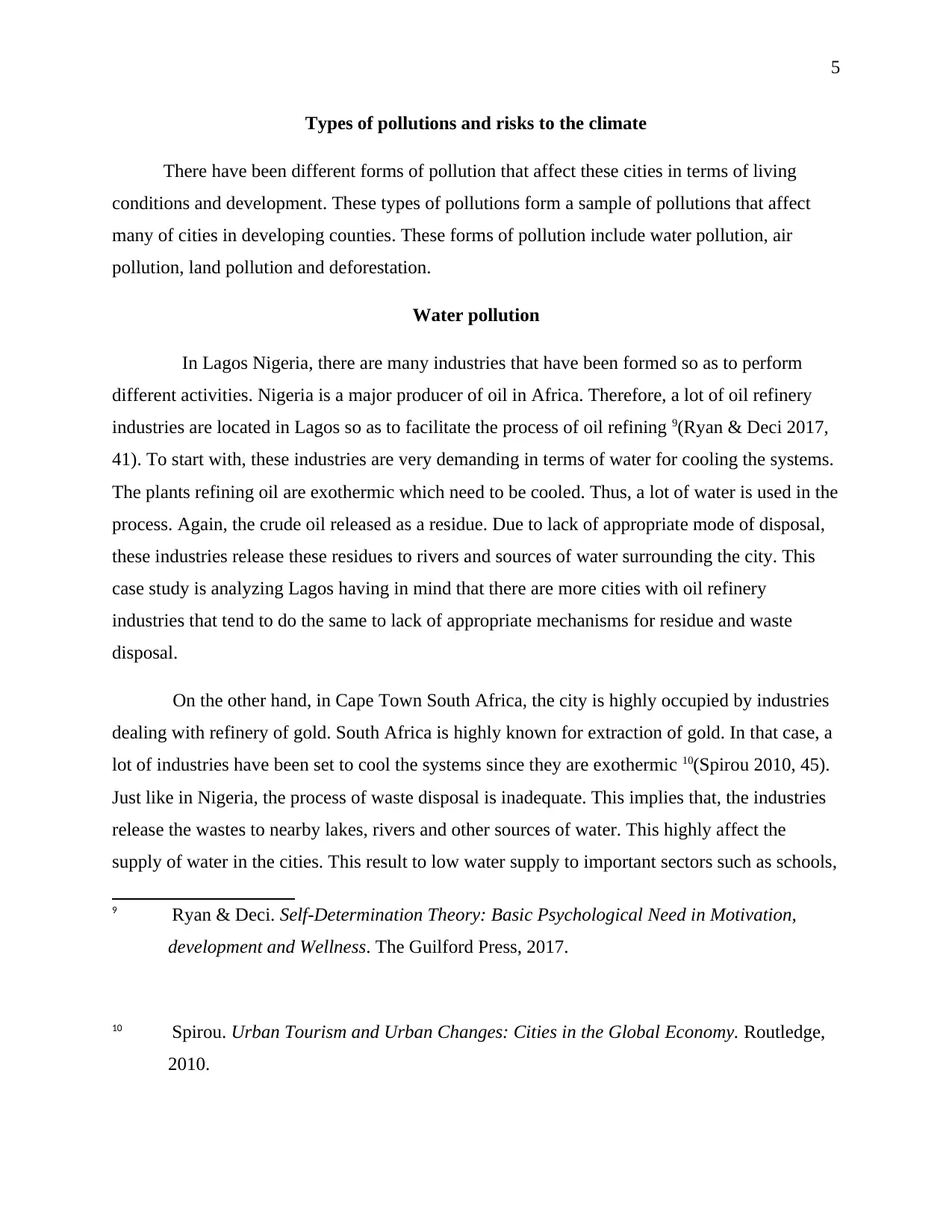
5
Types of pollutions and risks to the climate
There have been different forms of pollution that affect these cities in terms of living
conditions and development. These types of pollutions form a sample of pollutions that affect
many of cities in developing counties. These forms of pollution include water pollution, air
pollution, land pollution and deforestation.
Water pollution
In Lagos Nigeria, there are many industries that have been formed so as to perform
different activities. Nigeria is a major producer of oil in Africa. Therefore, a lot of oil refinery
industries are located in Lagos so as to facilitate the process of oil refining 9(Ryan & Deci 2017,
41). To start with, these industries are very demanding in terms of water for cooling the systems.
The plants refining oil are exothermic which need to be cooled. Thus, a lot of water is used in the
process. Again, the crude oil released as a residue. Due to lack of appropriate mode of disposal,
these industries release these residues to rivers and sources of water surrounding the city. This
case study is analyzing Lagos having in mind that there are more cities with oil refinery
industries that tend to do the same to lack of appropriate mechanisms for residue and waste
disposal.
On the other hand, in Cape Town South Africa, the city is highly occupied by industries
dealing with refinery of gold. South Africa is highly known for extraction of gold. In that case, a
lot of industries have been set to cool the systems since they are exothermic 10(Spirou 2010, 45).
Just like in Nigeria, the process of waste disposal is inadequate. This implies that, the industries
release the wastes to nearby lakes, rivers and other sources of water. This highly affect the
supply of water in the cities. This result to low water supply to important sectors such as schools,
9 Ryan & Deci. Self-Determination Theory: Basic Psychological Need in Motivation,
development and Wellness. The Guilford Press, 2017.
10 Spirou. Urban Tourism and Urban Changes: Cities in the Global Economy. Routledge,
2010.
Types of pollutions and risks to the climate
There have been different forms of pollution that affect these cities in terms of living
conditions and development. These types of pollutions form a sample of pollutions that affect
many of cities in developing counties. These forms of pollution include water pollution, air
pollution, land pollution and deforestation.
Water pollution
In Lagos Nigeria, there are many industries that have been formed so as to perform
different activities. Nigeria is a major producer of oil in Africa. Therefore, a lot of oil refinery
industries are located in Lagos so as to facilitate the process of oil refining 9(Ryan & Deci 2017,
41). To start with, these industries are very demanding in terms of water for cooling the systems.
The plants refining oil are exothermic which need to be cooled. Thus, a lot of water is used in the
process. Again, the crude oil released as a residue. Due to lack of appropriate mode of disposal,
these industries release these residues to rivers and sources of water surrounding the city. This
case study is analyzing Lagos having in mind that there are more cities with oil refinery
industries that tend to do the same to lack of appropriate mechanisms for residue and waste
disposal.
On the other hand, in Cape Town South Africa, the city is highly occupied by industries
dealing with refinery of gold. South Africa is highly known for extraction of gold. In that case, a
lot of industries have been set to cool the systems since they are exothermic 10(Spirou 2010, 45).
Just like in Nigeria, the process of waste disposal is inadequate. This implies that, the industries
release the wastes to nearby lakes, rivers and other sources of water. This highly affect the
supply of water in the cities. This result to low water supply to important sectors such as schools,
9 Ryan & Deci. Self-Determination Theory: Basic Psychological Need in Motivation,
development and Wellness. The Guilford Press, 2017.
10 Spirou. Urban Tourism and Urban Changes: Cities in the Global Economy. Routledge,
2010.
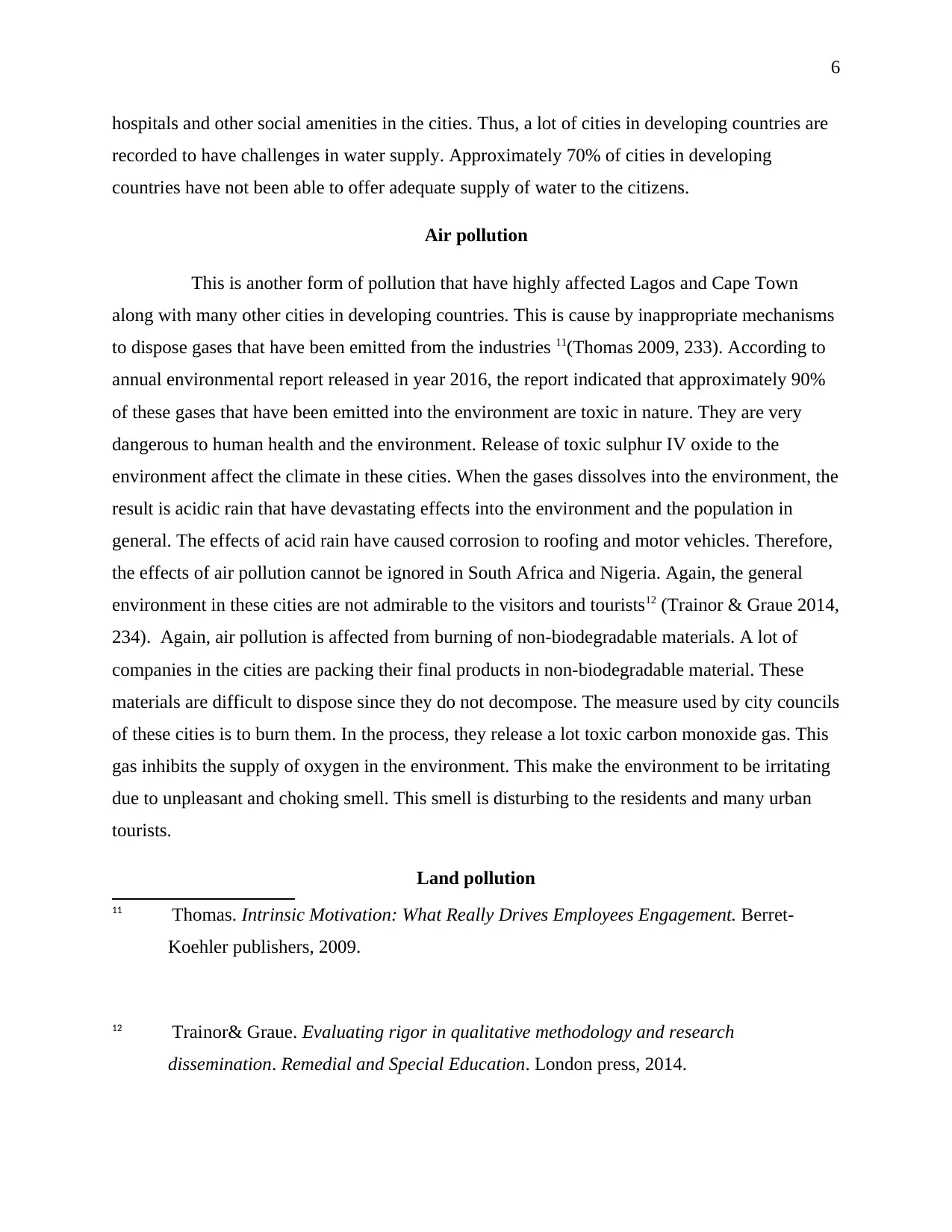
6
hospitals and other social amenities in the cities. Thus, a lot of cities in developing countries are
recorded to have challenges in water supply. Approximately 70% of cities in developing
countries have not been able to offer adequate supply of water to the citizens.
Air pollution
This is another form of pollution that have highly affected Lagos and Cape Town
along with many other cities in developing countries. This is cause by inappropriate mechanisms
to dispose gases that have been emitted from the industries 11(Thomas 2009, 233). According to
annual environmental report released in year 2016, the report indicated that approximately 90%
of these gases that have been emitted into the environment are toxic in nature. They are very
dangerous to human health and the environment. Release of toxic sulphur IV oxide to the
environment affect the climate in these cities. When the gases dissolves into the environment, the
result is acidic rain that have devastating effects into the environment and the population in
general. The effects of acid rain have caused corrosion to roofing and motor vehicles. Therefore,
the effects of air pollution cannot be ignored in South Africa and Nigeria. Again, the general
environment in these cities are not admirable to the visitors and tourists12 (Trainor & Graue 2014,
234). Again, air pollution is affected from burning of non-biodegradable materials. A lot of
companies in the cities are packing their final products in non-biodegradable material. These
materials are difficult to dispose since they do not decompose. The measure used by city councils
of these cities is to burn them. In the process, they release a lot toxic carbon monoxide gas. This
gas inhibits the supply of oxygen in the environment. This make the environment to be irritating
due to unpleasant and choking smell. This smell is disturbing to the residents and many urban
tourists.
Land pollution
11 Thomas. Intrinsic Motivation: What Really Drives Employees Engagement. Berret-
Koehler publishers, 2009.
12 Trainor& Graue. Evaluating rigor in qualitative methodology and research
dissemination. Remedial and Special Education. London press, 2014.
hospitals and other social amenities in the cities. Thus, a lot of cities in developing countries are
recorded to have challenges in water supply. Approximately 70% of cities in developing
countries have not been able to offer adequate supply of water to the citizens.
Air pollution
This is another form of pollution that have highly affected Lagos and Cape Town
along with many other cities in developing countries. This is cause by inappropriate mechanisms
to dispose gases that have been emitted from the industries 11(Thomas 2009, 233). According to
annual environmental report released in year 2016, the report indicated that approximately 90%
of these gases that have been emitted into the environment are toxic in nature. They are very
dangerous to human health and the environment. Release of toxic sulphur IV oxide to the
environment affect the climate in these cities. When the gases dissolves into the environment, the
result is acidic rain that have devastating effects into the environment and the population in
general. The effects of acid rain have caused corrosion to roofing and motor vehicles. Therefore,
the effects of air pollution cannot be ignored in South Africa and Nigeria. Again, the general
environment in these cities are not admirable to the visitors and tourists12 (Trainor & Graue 2014,
234). Again, air pollution is affected from burning of non-biodegradable materials. A lot of
companies in the cities are packing their final products in non-biodegradable material. These
materials are difficult to dispose since they do not decompose. The measure used by city councils
of these cities is to burn them. In the process, they release a lot toxic carbon monoxide gas. This
gas inhibits the supply of oxygen in the environment. This make the environment to be irritating
due to unpleasant and choking smell. This smell is disturbing to the residents and many urban
tourists.
Land pollution
11 Thomas. Intrinsic Motivation: What Really Drives Employees Engagement. Berret-
Koehler publishers, 2009.
12 Trainor& Graue. Evaluating rigor in qualitative methodology and research
dissemination. Remedial and Special Education. London press, 2014.
⊘ This is a preview!⊘
Do you want full access?
Subscribe today to unlock all pages.

Trusted by 1+ million students worldwide
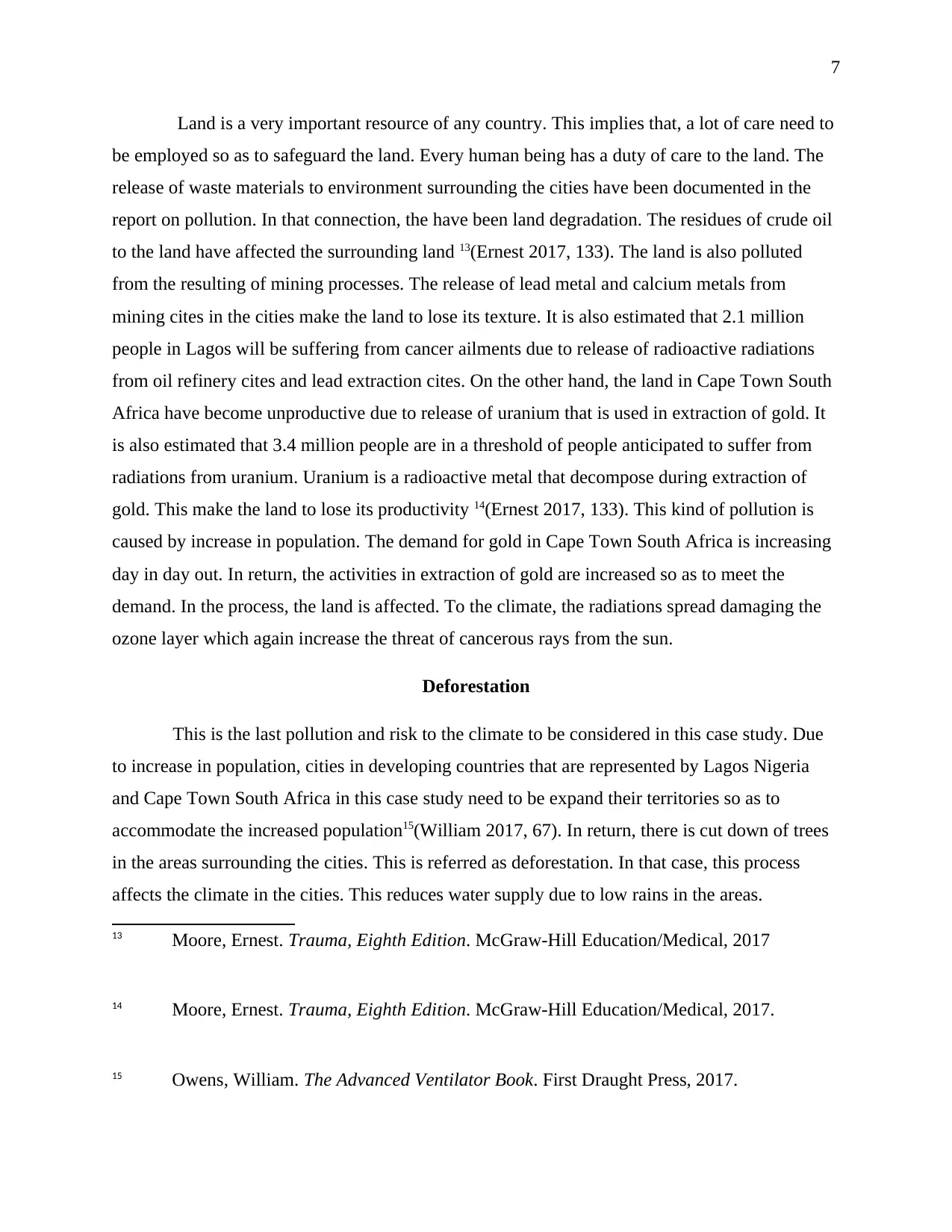
7
Land is a very important resource of any country. This implies that, a lot of care need to
be employed so as to safeguard the land. Every human being has a duty of care to the land. The
release of waste materials to environment surrounding the cities have been documented in the
report on pollution. In that connection, the have been land degradation. The residues of crude oil
to the land have affected the surrounding land 13(Ernest 2017, 133). The land is also polluted
from the resulting of mining processes. The release of lead metal and calcium metals from
mining cites in the cities make the land to lose its texture. It is also estimated that 2.1 million
people in Lagos will be suffering from cancer ailments due to release of radioactive radiations
from oil refinery cites and lead extraction cites. On the other hand, the land in Cape Town South
Africa have become unproductive due to release of uranium that is used in extraction of gold. It
is also estimated that 3.4 million people are in a threshold of people anticipated to suffer from
radiations from uranium. Uranium is a radioactive metal that decompose during extraction of
gold. This make the land to lose its productivity 14(Ernest 2017, 133). This kind of pollution is
caused by increase in population. The demand for gold in Cape Town South Africa is increasing
day in day out. In return, the activities in extraction of gold are increased so as to meet the
demand. In the process, the land is affected. To the climate, the radiations spread damaging the
ozone layer which again increase the threat of cancerous rays from the sun.
Deforestation
This is the last pollution and risk to the climate to be considered in this case study. Due
to increase in population, cities in developing countries that are represented by Lagos Nigeria
and Cape Town South Africa in this case study need to be expand their territories so as to
accommodate the increased population15(William 2017, 67). In return, there is cut down of trees
in the areas surrounding the cities. This is referred as deforestation. In that case, this process
affects the climate in the cities. This reduces water supply due to low rains in the areas.
13 Moore, Ernest. Trauma, Eighth Edition. McGraw-Hill Education/Medical, 2017
14 Moore, Ernest. Trauma, Eighth Edition. McGraw-Hill Education/Medical, 2017.
15 Owens, William. The Advanced Ventilator Book. First Draught Press, 2017.
Land is a very important resource of any country. This implies that, a lot of care need to
be employed so as to safeguard the land. Every human being has a duty of care to the land. The
release of waste materials to environment surrounding the cities have been documented in the
report on pollution. In that connection, the have been land degradation. The residues of crude oil
to the land have affected the surrounding land 13(Ernest 2017, 133). The land is also polluted
from the resulting of mining processes. The release of lead metal and calcium metals from
mining cites in the cities make the land to lose its texture. It is also estimated that 2.1 million
people in Lagos will be suffering from cancer ailments due to release of radioactive radiations
from oil refinery cites and lead extraction cites. On the other hand, the land in Cape Town South
Africa have become unproductive due to release of uranium that is used in extraction of gold. It
is also estimated that 3.4 million people are in a threshold of people anticipated to suffer from
radiations from uranium. Uranium is a radioactive metal that decompose during extraction of
gold. This make the land to lose its productivity 14(Ernest 2017, 133). This kind of pollution is
caused by increase in population. The demand for gold in Cape Town South Africa is increasing
day in day out. In return, the activities in extraction of gold are increased so as to meet the
demand. In the process, the land is affected. To the climate, the radiations spread damaging the
ozone layer which again increase the threat of cancerous rays from the sun.
Deforestation
This is the last pollution and risk to the climate to be considered in this case study. Due
to increase in population, cities in developing countries that are represented by Lagos Nigeria
and Cape Town South Africa in this case study need to be expand their territories so as to
accommodate the increased population15(William 2017, 67). In return, there is cut down of trees
in the areas surrounding the cities. This is referred as deforestation. In that case, this process
affects the climate in the cities. This reduces water supply due to low rains in the areas.
13 Moore, Ernest. Trauma, Eighth Edition. McGraw-Hill Education/Medical, 2017
14 Moore, Ernest. Trauma, Eighth Edition. McGraw-Hill Education/Medical, 2017.
15 Owens, William. The Advanced Ventilator Book. First Draught Press, 2017.
Paraphrase This Document
Need a fresh take? Get an instant paraphrase of this document with our AI Paraphraser
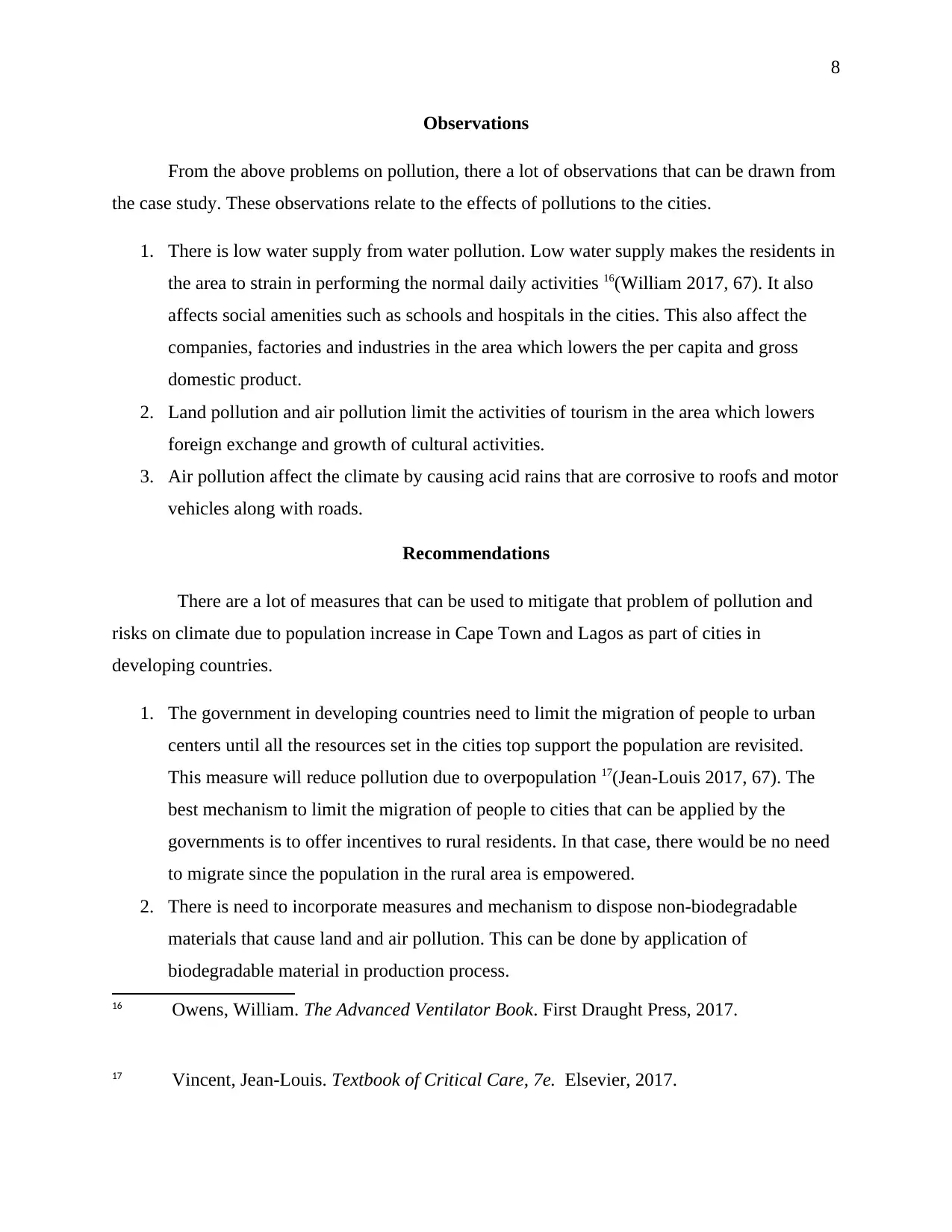
8
Observations
From the above problems on pollution, there a lot of observations that can be drawn from
the case study. These observations relate to the effects of pollutions to the cities.
1. There is low water supply from water pollution. Low water supply makes the residents in
the area to strain in performing the normal daily activities 16(William 2017, 67). It also
affects social amenities such as schools and hospitals in the cities. This also affect the
companies, factories and industries in the area which lowers the per capita and gross
domestic product.
2. Land pollution and air pollution limit the activities of tourism in the area which lowers
foreign exchange and growth of cultural activities.
3. Air pollution affect the climate by causing acid rains that are corrosive to roofs and motor
vehicles along with roads.
Recommendations
There are a lot of measures that can be used to mitigate that problem of pollution and
risks on climate due to population increase in Cape Town and Lagos as part of cities in
developing countries.
1. The government in developing countries need to limit the migration of people to urban
centers until all the resources set in the cities top support the population are revisited.
This measure will reduce pollution due to overpopulation 17(Jean-Louis 2017, 67). The
best mechanism to limit the migration of people to cities that can be applied by the
governments is to offer incentives to rural residents. In that case, there would be no need
to migrate since the population in the rural area is empowered.
2. There is need to incorporate measures and mechanism to dispose non-biodegradable
materials that cause land and air pollution. This can be done by application of
biodegradable material in production process.
16 Owens, William. The Advanced Ventilator Book. First Draught Press, 2017.
17 Vincent, Jean-Louis. Textbook of Critical Care, 7e. Elsevier, 2017.
Observations
From the above problems on pollution, there a lot of observations that can be drawn from
the case study. These observations relate to the effects of pollutions to the cities.
1. There is low water supply from water pollution. Low water supply makes the residents in
the area to strain in performing the normal daily activities 16(William 2017, 67). It also
affects social amenities such as schools and hospitals in the cities. This also affect the
companies, factories and industries in the area which lowers the per capita and gross
domestic product.
2. Land pollution and air pollution limit the activities of tourism in the area which lowers
foreign exchange and growth of cultural activities.
3. Air pollution affect the climate by causing acid rains that are corrosive to roofs and motor
vehicles along with roads.
Recommendations
There are a lot of measures that can be used to mitigate that problem of pollution and
risks on climate due to population increase in Cape Town and Lagos as part of cities in
developing countries.
1. The government in developing countries need to limit the migration of people to urban
centers until all the resources set in the cities top support the population are revisited.
This measure will reduce pollution due to overpopulation 17(Jean-Louis 2017, 67). The
best mechanism to limit the migration of people to cities that can be applied by the
governments is to offer incentives to rural residents. In that case, there would be no need
to migrate since the population in the rural area is empowered.
2. There is need to incorporate measures and mechanism to dispose non-biodegradable
materials that cause land and air pollution. This can be done by application of
biodegradable material in production process.
16 Owens, William. The Advanced Ventilator Book. First Draught Press, 2017.
17 Vincent, Jean-Louis. Textbook of Critical Care, 7e. Elsevier, 2017.
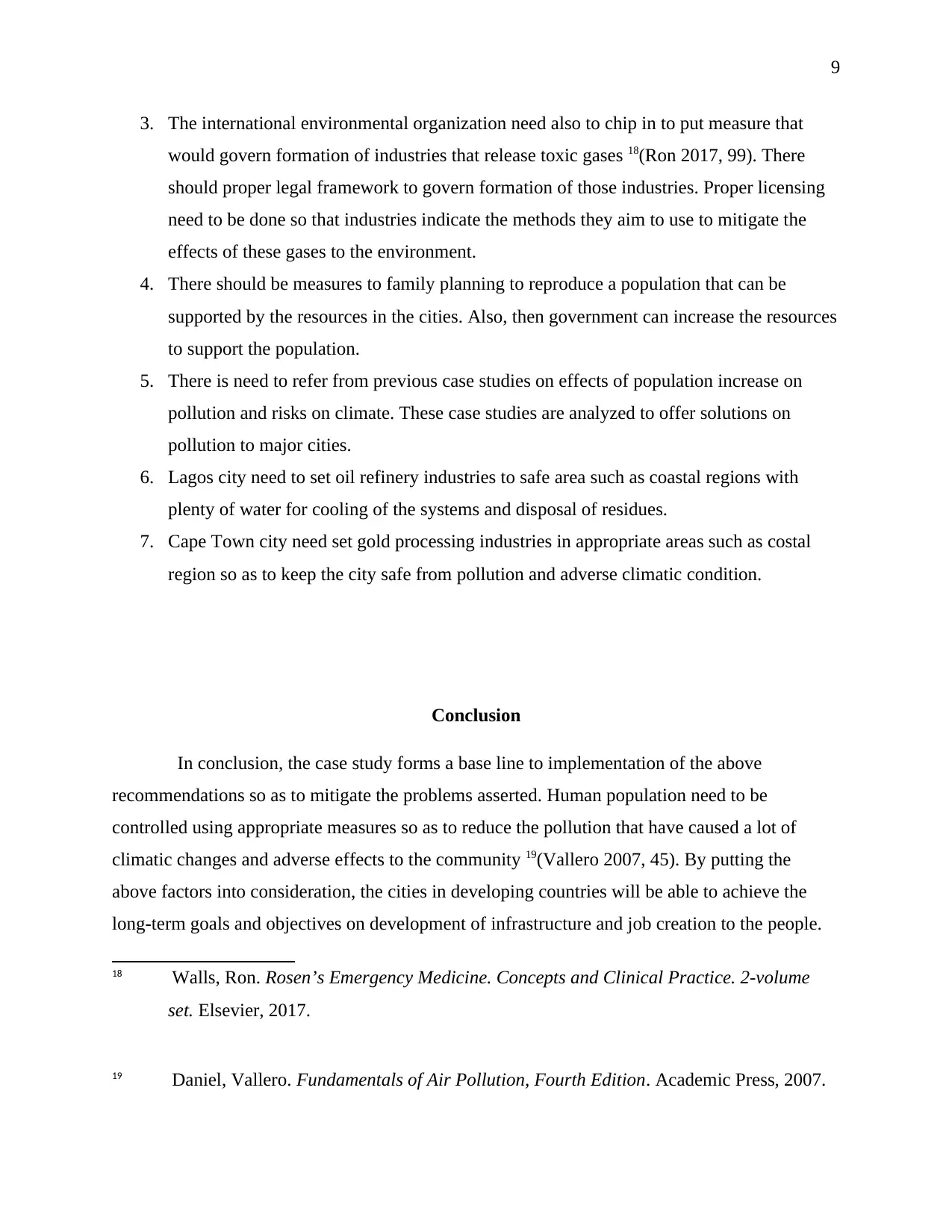
9
3. The international environmental organization need also to chip in to put measure that
would govern formation of industries that release toxic gases 18(Ron 2017, 99). There
should proper legal framework to govern formation of those industries. Proper licensing
need to be done so that industries indicate the methods they aim to use to mitigate the
effects of these gases to the environment.
4. There should be measures to family planning to reproduce a population that can be
supported by the resources in the cities. Also, then government can increase the resources
to support the population.
5. There is need to refer from previous case studies on effects of population increase on
pollution and risks on climate. These case studies are analyzed to offer solutions on
pollution to major cities.
6. Lagos city need to set oil refinery industries to safe area such as coastal regions with
plenty of water for cooling of the systems and disposal of residues.
7. Cape Town city need set gold processing industries in appropriate areas such as costal
region so as to keep the city safe from pollution and adverse climatic condition.
Conclusion
In conclusion, the case study forms a base line to implementation of the above
recommendations so as to mitigate the problems asserted. Human population need to be
controlled using appropriate measures so as to reduce the pollution that have caused a lot of
climatic changes and adverse effects to the community 19(Vallero 2007, 45). By putting the
above factors into consideration, the cities in developing countries will be able to achieve the
long-term goals and objectives on development of infrastructure and job creation to the people.
18 Walls, Ron. Rosen’s Emergency Medicine. Concepts and Clinical Practice. 2-volume
set. Elsevier, 2017.
19 Daniel, Vallero. Fundamentals of Air Pollution, Fourth Edition. Academic Press, 2007.
3. The international environmental organization need also to chip in to put measure that
would govern formation of industries that release toxic gases 18(Ron 2017, 99). There
should proper legal framework to govern formation of those industries. Proper licensing
need to be done so that industries indicate the methods they aim to use to mitigate the
effects of these gases to the environment.
4. There should be measures to family planning to reproduce a population that can be
supported by the resources in the cities. Also, then government can increase the resources
to support the population.
5. There is need to refer from previous case studies on effects of population increase on
pollution and risks on climate. These case studies are analyzed to offer solutions on
pollution to major cities.
6. Lagos city need to set oil refinery industries to safe area such as coastal regions with
plenty of water for cooling of the systems and disposal of residues.
7. Cape Town city need set gold processing industries in appropriate areas such as costal
region so as to keep the city safe from pollution and adverse climatic condition.
Conclusion
In conclusion, the case study forms a base line to implementation of the above
recommendations so as to mitigate the problems asserted. Human population need to be
controlled using appropriate measures so as to reduce the pollution that have caused a lot of
climatic changes and adverse effects to the community 19(Vallero 2007, 45). By putting the
above factors into consideration, the cities in developing countries will be able to achieve the
long-term goals and objectives on development of infrastructure and job creation to the people.
18 Walls, Ron. Rosen’s Emergency Medicine. Concepts and Clinical Practice. 2-volume
set. Elsevier, 2017.
19 Daniel, Vallero. Fundamentals of Air Pollution, Fourth Edition. Academic Press, 2007.
⊘ This is a preview!⊘
Do you want full access?
Subscribe today to unlock all pages.

Trusted by 1+ million students worldwide
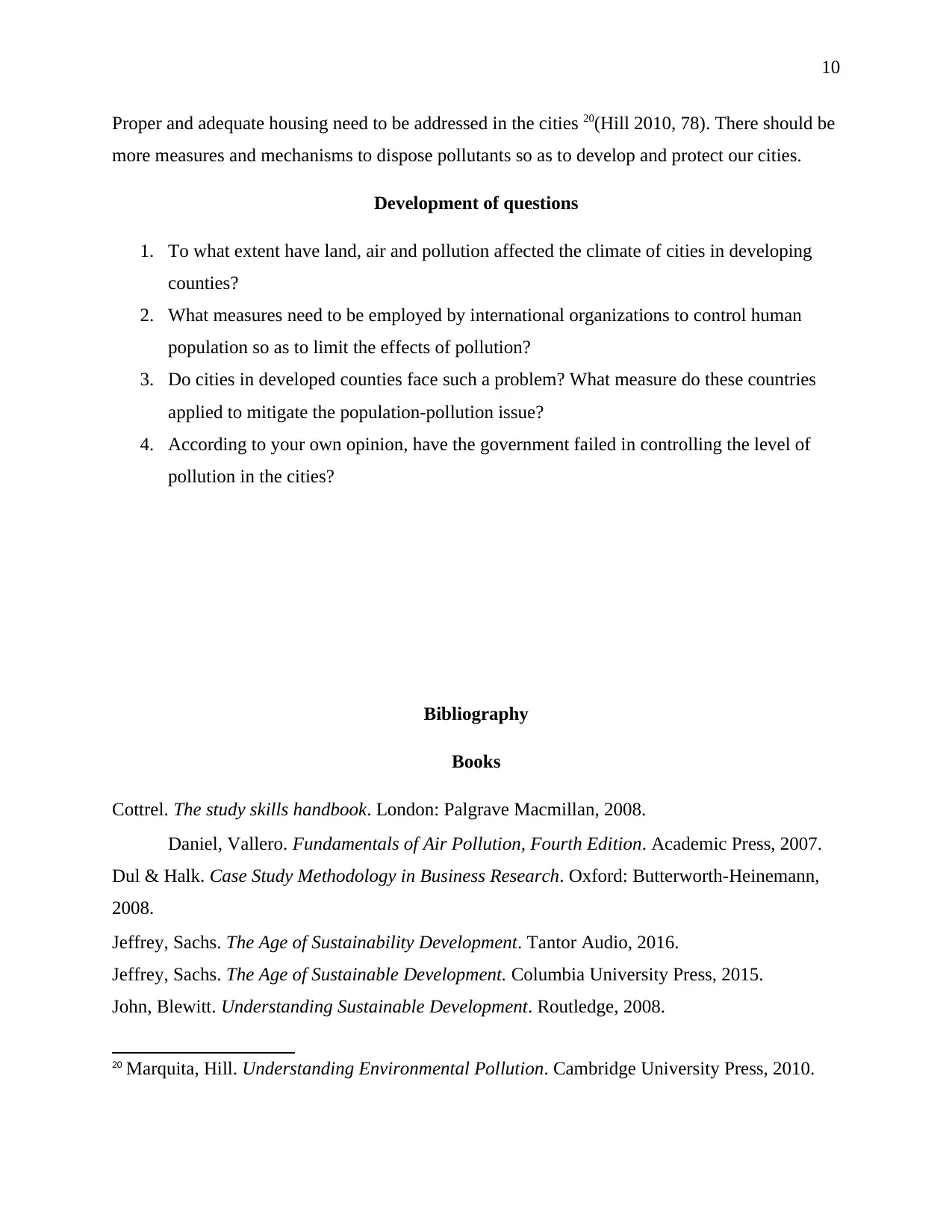
10
Proper and adequate housing need to be addressed in the cities 20(Hill 2010, 78). There should be
more measures and mechanisms to dispose pollutants so as to develop and protect our cities.
Development of questions
1. To what extent have land, air and pollution affected the climate of cities in developing
counties?
2. What measures need to be employed by international organizations to control human
population so as to limit the effects of pollution?
3. Do cities in developed counties face such a problem? What measure do these countries
applied to mitigate the population-pollution issue?
4. According to your own opinion, have the government failed in controlling the level of
pollution in the cities?
Bibliography
Books
Cottrel. The study skills handbook. London: Palgrave Macmillan, 2008.
Daniel, Vallero. Fundamentals of Air Pollution, Fourth Edition. Academic Press, 2007.
Dul & Halk. Case Study Methodology in Business Research. Oxford: Butterworth-Heinemann,
2008.
Jeffrey, Sachs. The Age of Sustainability Development. Tantor Audio, 2016.
Jeffrey, Sachs. The Age of Sustainable Development. Columbia University Press, 2015.
John, Blewitt. Understanding Sustainable Development. Routledge, 2008.
20 Marquita, Hill. Understanding Environmental Pollution. Cambridge University Press, 2010.
Proper and adequate housing need to be addressed in the cities 20(Hill 2010, 78). There should be
more measures and mechanisms to dispose pollutants so as to develop and protect our cities.
Development of questions
1. To what extent have land, air and pollution affected the climate of cities in developing
counties?
2. What measures need to be employed by international organizations to control human
population so as to limit the effects of pollution?
3. Do cities in developed counties face such a problem? What measure do these countries
applied to mitigate the population-pollution issue?
4. According to your own opinion, have the government failed in controlling the level of
pollution in the cities?
Bibliography
Books
Cottrel. The study skills handbook. London: Palgrave Macmillan, 2008.
Daniel, Vallero. Fundamentals of Air Pollution, Fourth Edition. Academic Press, 2007.
Dul & Halk. Case Study Methodology in Business Research. Oxford: Butterworth-Heinemann,
2008.
Jeffrey, Sachs. The Age of Sustainability Development. Tantor Audio, 2016.
Jeffrey, Sachs. The Age of Sustainable Development. Columbia University Press, 2015.
John, Blewitt. Understanding Sustainable Development. Routledge, 2008.
20 Marquita, Hill. Understanding Environmental Pollution. Cambridge University Press, 2010.
Paraphrase This Document
Need a fresh take? Get an instant paraphrase of this document with our AI Paraphraser
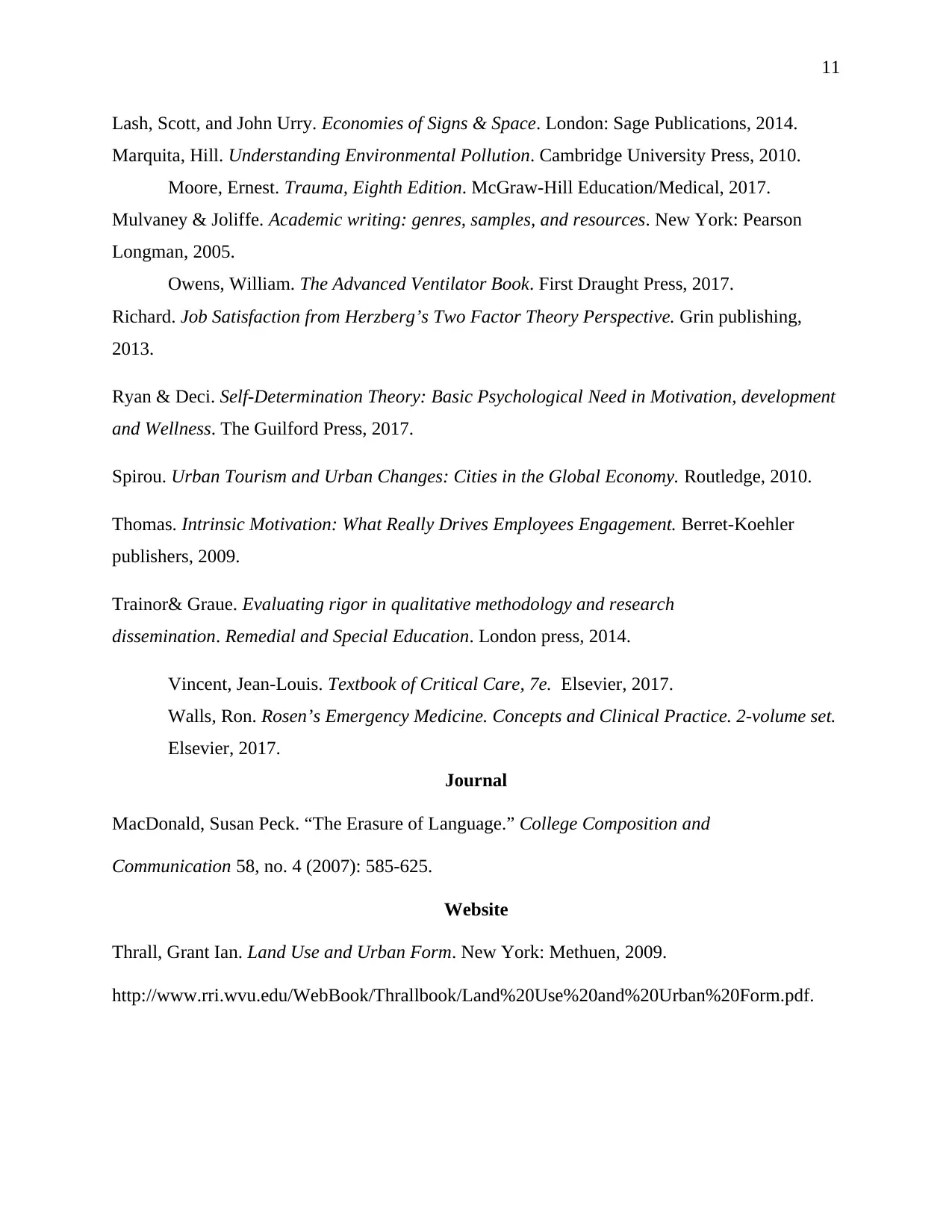
11
Lash, Scott, and John Urry. Economies of Signs & Space. London: Sage Publications, 2014.
Marquita, Hill. Understanding Environmental Pollution. Cambridge University Press, 2010.
Moore, Ernest. Trauma, Eighth Edition. McGraw-Hill Education/Medical, 2017.
Mulvaney & Joliffe. Academic writing: genres, samples, and resources. New York: Pearson
Longman, 2005.
Owens, William. The Advanced Ventilator Book. First Draught Press, 2017.
Richard. Job Satisfaction from Herzberg’s Two Factor Theory Perspective. Grin publishing,
2013.
Ryan & Deci. Self-Determination Theory: Basic Psychological Need in Motivation, development
and Wellness. The Guilford Press, 2017.
Spirou. Urban Tourism and Urban Changes: Cities in the Global Economy. Routledge, 2010.
Thomas. Intrinsic Motivation: What Really Drives Employees Engagement. Berret-Koehler
publishers, 2009.
Trainor& Graue. Evaluating rigor in qualitative methodology and research
dissemination. Remedial and Special Education. London press, 2014.
Vincent, Jean-Louis. Textbook of Critical Care, 7e. Elsevier, 2017.
Walls, Ron. Rosen’s Emergency Medicine. Concepts and Clinical Practice. 2-volume set.
Elsevier, 2017.
Journal
MacDonald, Susan Peck. “The Erasure of Language.” College Composition and
Communication 58, no. 4 (2007): 585-625.
Website
Thrall, Grant Ian. Land Use and Urban Form. New York: Methuen, 2009.
http://www.rri.wvu.edu/WebBook/Thrallbook/Land%20Use%20and%20Urban%20Form.pdf.
Lash, Scott, and John Urry. Economies of Signs & Space. London: Sage Publications, 2014.
Marquita, Hill. Understanding Environmental Pollution. Cambridge University Press, 2010.
Moore, Ernest. Trauma, Eighth Edition. McGraw-Hill Education/Medical, 2017.
Mulvaney & Joliffe. Academic writing: genres, samples, and resources. New York: Pearson
Longman, 2005.
Owens, William. The Advanced Ventilator Book. First Draught Press, 2017.
Richard. Job Satisfaction from Herzberg’s Two Factor Theory Perspective. Grin publishing,
2013.
Ryan & Deci. Self-Determination Theory: Basic Psychological Need in Motivation, development
and Wellness. The Guilford Press, 2017.
Spirou. Urban Tourism and Urban Changes: Cities in the Global Economy. Routledge, 2010.
Thomas. Intrinsic Motivation: What Really Drives Employees Engagement. Berret-Koehler
publishers, 2009.
Trainor& Graue. Evaluating rigor in qualitative methodology and research
dissemination. Remedial and Special Education. London press, 2014.
Vincent, Jean-Louis. Textbook of Critical Care, 7e. Elsevier, 2017.
Walls, Ron. Rosen’s Emergency Medicine. Concepts and Clinical Practice. 2-volume set.
Elsevier, 2017.
Journal
MacDonald, Susan Peck. “The Erasure of Language.” College Composition and
Communication 58, no. 4 (2007): 585-625.
Website
Thrall, Grant Ian. Land Use and Urban Form. New York: Methuen, 2009.
http://www.rri.wvu.edu/WebBook/Thrallbook/Land%20Use%20and%20Urban%20Form.pdf.

12
⊘ This is a preview!⊘
Do you want full access?
Subscribe today to unlock all pages.

Trusted by 1+ million students worldwide
1 out of 12
Related Documents
Your All-in-One AI-Powered Toolkit for Academic Success.
+13062052269
info@desklib.com
Available 24*7 on WhatsApp / Email
![[object Object]](/_next/static/media/star-bottom.7253800d.svg)
Unlock your academic potential
Copyright © 2020–2025 A2Z Services. All Rights Reserved. Developed and managed by ZUCOL.





